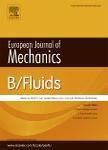版权所有:内蒙古大学图书馆 技术提供:维普资讯• 智图
内蒙古自治区呼和浩特市赛罕区大学西街235号 邮编: 010021

作者机构:Nanjing Univ Aeronaut & Astronaut Coll Energy & Power Engn Nanjing 210016 Peoples R China Inner Mongolia Univ Technol Coll Aviat Hohhot 010051 Peoples R China
出 版 物:《EUROPEAN JOURNAL OF MECHANICS B-FLUIDS》 (Eur J Mech B Fluids)
年 卷 期:2025年第109卷
页 面:367-377页
核心收录:
学科分类:08[工学] 080101[工学-一般力学与力学基础] 0702[理学-物理学] 0801[工学-力学(可授工学、理学学位)]
基 金:Advanced Aerospace Force Inno-vation Workstation in China [HKCX2020-02-020] Funda-mental Research Funds for the Autonomous Region Universities [JY20220292]
主 题:Fluid oscillator Structural parameters Flow characteristics Oscillation characteristics CFD Hot-wire anemometer
摘 要:The fluid oscillator, relying on the Coanda effect, is a flow control device that can alter the direction or velocity of a jet both spatially and temporally. The fuel injection device based on a fluid oscillator significantly enhances atomization and spatial dispersion performance compared to a direct-spray nozzle. However, when used in high heat load afterburners with aviation kerosene as the working medium, oxidative coking issues may arise. To address this, it is recommended to use premixed rich fuel-vapor as the working fluid in order to reduce the residence time of fuel in the oscillator. This study investigates the flow rate and frequency variation of ideal air (simulated gas phase fuel) as it moves through a double feedback channel fluid oscillator with varying thicknesses and outlet throat widths. Experimental and numerical simulation methods are employed. And the influence mechanism is analyzed through an examination of the flow field structure within the cavity of the fluid oscillator. The results indicate that increasing the thickness of the fluid oscillator leads to a higher outlet tangential velocity and deflection angle, while simultaneously decreasing the oscillation frequency. Conversely, widening the fluid oscillator throat results in a decrease in tangential velocity, deflection angle, and oscillation frequency. The performance of the fluid oscillator reaches a critical threshold when the outlet throat is square. As thickness increases, the rate of decrease in oscillation frequency and the rate of increase in tangential velocity both slow down. Furthermore, the maximum deflection angle of the airflow at the oscillator outlet reaches a critical value at a thickness of 3.375 mm, beyond which the trend of increasing deflection angle also slows. When the thickness of the oscillator is less than 3.375 mm, mass flow is the predominant driving factor for airflow deflection in the mixing chamber. In contrast, when the thickness is greater than or equal to